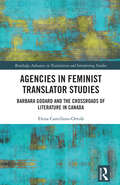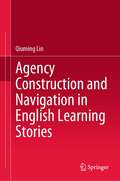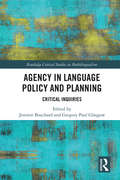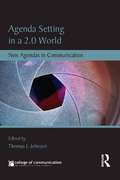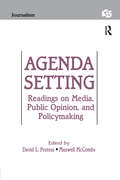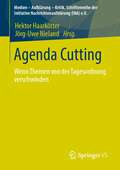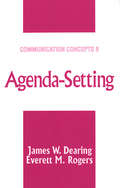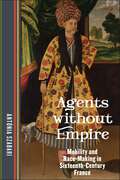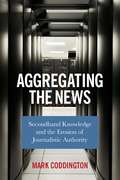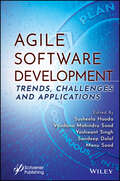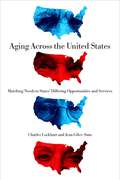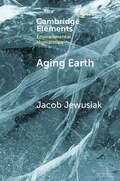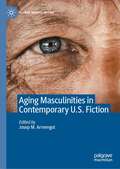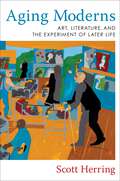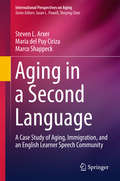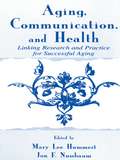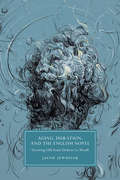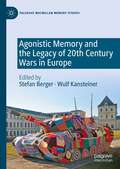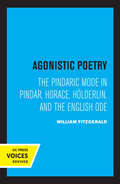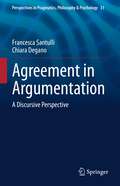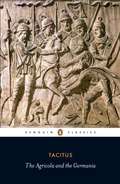- Table View
- List View
Agencies in Feminist Translator Studies: Barbara Godard and the Crossroads of Literature in Canada (ISSN)
by Elena Castellano-OrtolàThis book sets out a new framework for a feminist history of translators, drawing on the legacy of Canadian scholar Barbara Godard and her work in establishing the Canadian literary landscape as a means of exploring agency in feminist translation studies and its implications for cross-disciplinary debates.The volume is organised in three sections, establishing feminist translator studies as its own approach, examining these dynamics at work in a comprehensive portrait of Barbara Godard’s scholarly and literary history, and looking ahead to future directions. In situating the discussion on Godard and Canadian literary history, Elena Castellano calls attention to a geographic context in which translation and its practice has been at the heart of debates around national identity and intersected with the rise of feminism and feminist literary scholarship. The book demonstrates how an in-depth exploration of the agency of an individual stakeholder, whose activities spanned diverse communities and oft conflicting interests, can engage in key questions at the intersection of nation-making, translation, and feminism, paving the way for future research and the further development of feminist translator studies as methodological framework.This book will be of interest to scholars in translation studies, feminist literature, cultural history, and Canadian literature.
Agency Construction and Navigation in English Learning Stories
by Qiuming LinThis book presents a longitudinal research which covers a linguistic approach to understand and observe language learner agency. It makes connections between agency in discourse analyses and agency in applied linguistics by examining how learner agency is manifested in autobiographic oral narratives and influenced by contextual factors. This book also demonstrates that agency is not a fixed entity that English learners possess, but a dynamic construct constantly negotiated by the learners with the social world. It is the result of their identity positioning and repositioning within a complex and ever-changing context. Learner identities, either actual or imagined, are significantly correlated with their investment in English and their English learning process.This book sheds new light on teaching English as a foreign language and gives inspirations for enhancing English learners’ agency in contemporary context of China. As learner agency should be treated in a dynamic and process view, a low level of agency manifested in a particular period or in a certain context may not necessarily persist in later periods or extend to other contexts. Provided with supportive contextual conditions and taking on positive and powerful identities, language learners are well on the course for higher levels of agency.
Agency in Language Policy and Planning: Critical Inquiries (Routledge Critical Studies in Multilingualism)
by Jeremie Bouchard Gregory Paul GlasgowThis collection brings together theory and ethnographic research from a range of national contexts to offer unique insights into the nature of agency in language policy and planning. Situated within a broader sociological framework, the book explores agentive processes at work in case studies from around the world, engaging in discussions of such key themes as language and identity, language ideologies, linguistic diversity in education, and language revitalization. Each chapter examines the ways in which decisions made at both the local and national level impact language use and in turn, the dynamic relationship between language use, policy, and practice in these contexts. Taken together, this volume advances our understanding of agency in language policy and planning and directions for future research, making this key reading for students and scholars in language and education, critical sociolinguistics, and applied linguistics.
Agency in Transnational Memory Politics (Worlds of Memory #4)
by Jenny Wüstenberg and Aline SierpThe dynamics of transnational memory play a central role in modern politics, from postsocialist efforts at transitional justice to the global legacies of colonialism. Yet, the relatively young subfield of transnational memory studies remains underdeveloped and fractured across numerous disciplines, even as nascent, boundary-crossing theories on topics such as multi-vocal, traveling, or entangled remembrance suggest new ways of negotiating difficult political questions. This volume brings together theoretical and practical considerations to provide transnational memory scholars with an interdisciplinary investigation into agency—the “who” and the “how” of cross-border commemoration that motivates activists and fascinates observers.
Agency in Transnational Memory Politics (Worlds of Memory #4)
by Jenny Wüstenberg and Aline SierpThe dynamics of transnational memory play a central role in modern politics, from postsocialist efforts at transitional justice to the global legacies of colonialism. Yet, the relatively young subfield of transnational memory studies remains underdeveloped and fractured across numerous disciplines, even as nascent, boundary-crossing theories on topics such as multi-vocal, traveling, or entangled remembrance suggest new ways of negotiating difficult political questions. This volume brings together theoretical and practical considerations to provide transnational memory scholars with an interdisciplinary investigation into agency—the “who” and the “how” of cross-border commemoration that motivates activists and fascinates observers.
Agenda Setting in a 2.0 World: New Agendas in Communication (New Agendas in Communication Series)
by Thomas J. JohnsonThis volume explores agenda-setting theory in light of changes in the media environment in the 21st century. In the decades since the original Chapel Hill study that launched agenda-setting research, the theory has attracted the interest of scholars worldwide. Agenda Setting in a 2.0 World features the work of a new generation of scholars. The research provided by these young scholars reflects two broad contemporary trends in agenda-setting: A centrifugal trend of research in the expanding media landscape and in domains beyond the original focus on public affairs, and a centripetal trend further explicating agenda-setting’s core concepts.
Agenda Setting: Readings on Media, Public Opinion, and Policymaking (Routledge Communication Series)
by Maxwell McCombs David L. ProtessThe role of the news media in defining the important issues of the day, also known as the agenda-setting influence of mass communication, has received widespread attention over the past 20 years. Since the publication of McCombs and Shaw's seminal empirical study, more than one hundred journal articles and monographs have appeared. This collection exemplifies the major phases of research on agenda-setting: tests of the basic hypothesis, contingent conditions affecting the strength of this influence, the natural history of public issues, mass media influence on public policy, and the role of external sources from the president to public relations staffs on the news agenda.
Agenda-Cutting: Wenn Themen von der Tagesordnung verschwinden (Medien – Aufklärung – Kritik. Schriftenreihe der Initiative Nachrichtenaufklärung (INA) e.V.)
by Jörg-Uwe Nieland Hektor HaarkötterWenn von Nachrichtenauswahl und Thematisierungsfunktion der Medien die Rede ist, fällt schnell das Fachwort Agenda-Setting. Der gegenteilige Begriff, das Agenda-Cutting, ist dagegen viel seltener Gegenstand von wissenschaftlichen oder gesellschaftlichen Diskussionen. Dabei ist das Agenda-Cutting eine weitflächig geübte Praxis in Medien, Politik und Gesellschaft, bei der Themen bewusst oder unbewusst aus den gesellschaftlichen Diskursen entfernt oder herausgehalten werden. Die Initiative Nachrichtenaufklärung beschäftigt sich schon lange intensiv mit der Frage der Vernachlässigung von Themen und Nachrichten. Mit diesem Sammelband wird erstmals das Thema wissenschaftlich tiefgehend von verschiedenen Seiten aus betrachtet.
Agenda-Setting
by Everett M. Rogers James W. DearingWhat is the major social problem in the news today? Who made it so important? Social issues that are widely recognized on the media agenda often demand attention on the public agenda, and in turn move quickly up the policy agenda, creating policy changes. Based on research of contemporary social issues that have hit the headlines - including the war on drugs, drink-driving, the Exxon Valdez oil spillage, AIDS and the Ethiopian famine - this book provides important theoretical and practical insights into the agenda-setting process and its role in effecting social change.
Agents without Empire: Mobility and Race-Making in Sixteenth-Century France
by Antónia SzabariIt is well known that Renaissance culture gave an empowering role to the individual and thereby to agency. But how does race factor into this culture of empowerment? Canonical French authors like Rabelais and Montaigne have been celebrated for their flexible worldviews and interest in the difference of non-French cultures both inside and outside of Europe. As a result, this period in French cultural history has come to be valued as an exceptional era of cultural opening toward others. Agents without Empire shows that such a celebration is, at the very least, problematic. Szabari argues that before the rise of the French colonial empire, medieval categories of race based on the redemption story were recast through accounts of the Ottoman Empire that were made accessible, in a sudden and unprecedented manner, to agents of the French crown. Spying performed by Frenchmen in the Ottoman Empire in the sixteenth century permeated French culture in large part because those who spied also worked as knowledge producers, propagandists, and artists. The practice changed what it meant to be cultured and elite by creating new avenues of race- and gender-specific consumption for French and European men that affected all areas of sophisticated culture including literature, politics, prints, dressing, personal hygiene, and leisure.Agents without Empire explores race making in this period of European history in the context of diplomatic reposts, travel accounts, natural history, propaganda, religious literature, poetry, theater, fiction, and cheap print. It intervenes in conversations in whiteness studies, race theory, theories of agency and matter, and the history of diplomacy and spying to offer a new account of race making in early modern Europe.
Aggregating the News: Secondhand Knowledge and the Erosion of Journalistic Authority
by Mark CoddingtonAggregated news fills our social media feeds, our smartphone apps, and our e-mail inboxes. Much of the news that we consume originated elsewhere and has been reassembled, repackaged, and republished from other sources, but how is that news made? Is it a twenty-first-century digital adaptation of the traditional values and practices of journalistic and investigative reporting, or is it something different—shoddier, less scrupulous, more dangerous? <P><P>Mark Coddington gives a vivid account of the work of aggregation—how such content is produced, what its values are, and how it fits into today’s changing journalistic profession. Aggregating the News presents an analysis built on observation and interviews of news aggregators in a variety of settings, exploring how aggregators weigh sources, reshape news narratives, and manage life on the fringes of journalism. Coddington finds that aggregation is defined by its derivative relationship to reporting, which colors it with a sense of inferiority. Aggregators strive to be seen as legitimate journalists, but they are constrained by commercial pressures, professional disapproval, and limited access to important forms of evidence. The first comprehensive treatment of news aggregation as a practice, Aggregating the News deepens our understanding of how news and knowledge are produced and consumed in the digital age. By centering aggregation, Coddington sheds new light on how journalistic authority and legitimacy are created—and the consequences when their foundations are eroded.
Aggressive Fictions: Reading the Contemporary American Novel
by Kathryn HumeA frequent complaint against contemporary American fiction is that too often it puts off readers in ways they find difficult to fathom. Books such as Bret Easton Ellis's American Psycho, Katherine Dunn's Geek Love, and Don DeLillo's Underworld seem determined to upset, disgust, or annoy their readers—or to disorient them by shunning traditional plot patterns and character development. Kathryn Hume calls such works "aggressive fiction." Why would authors risk alienating their readers—and why should readers persevere? Looking beyond the theory-based justifications that critics often provide for such fiction, Hume offers a commonsense guide for the average reader who wants to better understand and appreciate books that might otherwise seem difficult to enjoy. In her reliable and sympathetic guide, Hume considers roughly forty works of recent American fiction, including books by William Burroughs, Kathy Acker, Chuck Palahniuk, and Cormac McCarthy. Hume gathers "attacks" on the reader into categories based on narrative structure and content. Writers of some aggressive fictions may wish to frustrate easy interpretation or criticism. Others may try to induce certain responses in readers. Extreme content deployed as a tactic for distancing and alienating can actually produce a contradictory effect: for readers who learn to relax and go with the flow, the result may well be exhilaration rather than revulsion.
Agile Software Development: Trends, Challenges and Applications
by Yashwant Singh Susheela Hooda Vandana Mohindru Sood Sandeep Dalal Manu SoodAGILE SOFTWARE DEVELOPMENT A unique title that introduces the whole range of agile software development processes from the fundamental concepts to the highest levels of applications such as requirement analysis, software testing, quality assurance, and risk management. Agile Software Development (ASD) has become a popular technology because its methods apply to any programming paradigm. It is important in the software development process because it emphasizes incremental delivery, team collaboration, continuous planning, and learning over delivering everything at once near the end. Agile has gained popularity as a result of its use of various frameworks, methods, and techniques to improve software quality. Scrum is a major agile framework that has been widely adopted by the software development community. Metaheuristic techniques have been used in the agile software development process to improve software quality and reliability. These techniques not only improve quality and reliability but also test cases, resulting in cost-effective and time-effective software. However, many significant research challenges must be addressed to put such ASD capabilities into practice. With the use of diverse techniques, guiding principles, artificial intelligence, soft computing, and machine learning, this book seeks to study theoretical and technological research findings on all facets of ASD. Also, it sheds light on the latest trends, challenges, and applications in the area of ASD. This book explores the theoretical as well as the technical research outcomes on all the aspects of Agile Software Development by using various methods, principles, artificial intelligence, soft computing, and machine learning. Audience The book is designed for computer scientists and software engineers both in research and industry. Graduate and postgraduate students will find the book accessible as well.
Aging Across the United States: Matching Needs to States’ Differing Opportunities and Services
by Charles Lockhart Jean Giles-SimsOlder Americans experience stages of aging with distinct priorities. For younger retirees, climate can be most important; for older retirees, quality of health care. Various states support these and other priorities to sharply different degrees. While many Americans know which states offer mild climates for outdoor recreation, they rarely know which states offer the best medical care to Medicare patients. This book tells them and suggests sequential moves to take advantage of states’ varying strengths.
Aging Earth: Senescent Environmentalism for Dystopian Futures (Elements in Environmental Humanities)
by Jacob JewusiakAlarmist demography often situates older people as natural disasters: images of the 'gray flood' and 'silver tsunami' imbue senescence with the destructive force of climatic proportions. This Element focuses on the demographic dread arising from the relative shift in younger and older populations: not of a world lacking children, but of one catastrophized by the overabundance of the old and aging. Drawing on examples of science fictional sterility dystopias, Aging Earth challenges the privilege of youth in ecocritical thought and practice, especially the heteronormative urgency to address climate change for the sake of children and future generations. By decoupling the figurative connection between futurity and children, senescent environmentalism attunes itself to the contingency of non-linear and non-teleological futures: drawing together the delicacy of ecosystems on the brink with the structural precarity of older people, queers, and people of color.
Aging Masculinities in Contemporary U.S. Fiction (Global Masculinities)
by Josep M. ArmengolThis book focuses on representations of aging masculinities in contemporary U.S. fiction, including shifting perceptions of physical and sexual prowess, depression, and loss, but also greater wisdom and confidence, legacy, as well as new affective patterns. The collection also incorporates factors such as race, sexuality and religion. The volume includes studies, amongst others, on Philip Roth, Paul Auster, Toni Morrison, Ernest Gaines, and Edmund White. Ultimately, this study proves that men’s aging experiences as described in contemporary U.S. literature and culture are as complex and varied as those of their female counterparts.
Aging Moderns: Art, Literature, and the Experiment of Later Life
by Scott HerringWhat happens when the avant-garde grows old? Examining a group of writers and artists who continued the modernist experiment into later life, Scott Herring reveals how their radical artistic principles set out a new path for creative aging.Aging Moderns provides portraits of writers and artists who sought out or employed unconventional methods and collaborations up until the early twenty-first century. Herring finds Djuna Barnes performing the principles of high modernism not only in poetry but also in pharmacy orders and grocery lists. In mystery novels featuring Gertrude Stein and Alice B. Toklas along with modernist souvenir collections, the gay writer Samuel Steward elaborated a queer theory of aging and challenged gay male ageism. The Harlem Renaissance dancer Mabel Hampton dispelled stereotypes about aging through her queer of color performances at the Lesbian Herstory Archives. Herring explores Ivan Albright’s magic realist portraits of elders, Tillie Olsen’s writings on the aging female worker, and the surrealistic works made by Charles Henri Ford and his caregiver Indra Bahadur Tamang at the Dakota apartment building in New York City.Showcasing previously unpublished experimental art and writing, this deeply interdisciplinary book unites new modernist studies, American studies, disability studies, and critical age studies. Aging Moderns rethinks assumptions about literary creativity, the depiction of old age, and the boundaries of modernism.
Aging in a Second Language: A Case Study of Aging, Immigration, and an English Learner Speech Community (International Perspectives on Aging #17)
by Steven L. Arxer Maria del Puy Ciriza Marco ShappeckThis unique account of English language acquisition by Latino elders shines intimate light on the increasingly complex concerns of aging immigrant minority populations. Rich qualitative findings detail sociocultural barriers to and social and emotive factors that promote second language acquisition in older age. The book's case study highlights diverse cognitive and social processes as elders establish a sense of self as learners and as part of a learning community, and a sense of place as newcomers navigating a challenging environment. And first-person comments from the group members deftly illustrate the intricacies of being an immigrant in a rapidly changing America as well as the myriad intersections of race/ethnicity, gender, culture, and country that shape immigrant life. Included in the coverage: Minority aging in an immigrant context. Late-life second language acquisition: cognitive and psycholinguistic changes, challenges, and opportunities. Building emotions for self-identity and learning. Practicing safe language socialization in private and public spaces. Language resocialization and gender allies. Aging, second language acquisition, and health. Aging in a Second Language gives clinical social workers, gerontologists, health and cross-cultural psychologists, sociologists, educators and other professionals deep insights into the lives of an emerging active elder population. It also pinpoints challenges and opportunities in research, literacy program design, pedagogy, clinical outreach, education policy, and service delivery to immigrant elders.
Aging, Communication, and Health: Linking Research and Practice for Successful Aging (Routledge Communication Series)
by Jon F. Nussbaum Mary Lee HummertThis collection highlights the current efforts by scholars and researchers to understand the aging process as it relates to the health of older adults. With contributions from international scholars in communication, psychology, public health, medicine, nursing, and other areas, this volume emphasizes communication as a critical research, education, policy, and practice issue for the design, provision, and evaluation of health and social services for older adults. Organized into sections addressing communication developments in the healthcare arena, issues in provider-patient communication, and the relationships between family communication and health. The chapters cover critical topics related to successful aging, such as Alzheimer's disease, managed care and older adults, communication issues of severe dementia, and healthcare decision-making within families. The editors have designed this volume to be accessible to a broad audience, including scholars and students of aging and communication, healthcare practitioners with older clients, and aging individuals and their families who are pursuing strategies for successful aging. The chapters represent the highest levels of current scholarship on communication, aging, and health, providing a strong foundation for future research. Each contribution also addresses the applied implications of this research, offering practical guidance to readers dealing with these issues in their own lives. As a whole, Aging, Communication, and Health represents a major advance toward understanding the importance and application of communication for successful aging.
Aging, Duration, and the English Novel: Growing Old from Dickens to Woolf (Cambridge Studies in Nineteenth-Century Literature and Culture #120)
by Jacob JewusiakThe rapid onset of dementia after an illness, the development of gray hair after a traumatic loss, the sudden appearance of a wrinkle in the brow of a spurned lover. The realist novel uses these conventions to accelerate the process of aging into a descriptive moment, writing the passage of years on the body all at once. Aging, Duration, and the English Novel argues that the formal disappearance of aging from the novel parallels the ideological pressure to identify as being young by repressing the process of growing old. The construction of aging as a shameful event that should be hidden - to improve one's chances on the job market or secure a successful marriage - corresponds to the rise of the long novel, which draws upon the temporality of the body to map progress and decline onto the plots of nineteenth-century British modernity.
Agonistic Memory and the Legacy of 20th Century Wars in Europe (Palgrave Macmillan Memory Studies)
by Stefan Berger Wulf KansteinerThis book discusses the merits of the theory of agonistic memory in relation to the memory of war. After explaining the theory in detail it provides two case studies, one on war museums in contemporary Europe and one on mass graves exhumations, which both focus on analyzing to what extent these memory sites produce different regimes of memory. Furthermore, the book provides insights into the making of an agonistic exhibition at the Ruhr Museum in Essen, Germany. It also analyses audience reaction to a theatre play scripted and performed by the Spanish theatre company Micomicion that was supposed to put agonism on stage. There is also an analysis of a Massive Open Online Course (MOOC) designed and delivered on the theory of agonistic memory and its impact on the memory of war. Finally, the book provides a personal review of the history, problems and accomplishments of the theory of agonistic memory by the two editors of the volume.
Agonistic Poetry: The Pindaric Mode in Pindar, Horace, Hölderlin, and the English Ode
by William FitzgeraldThis title is part of UC Press’s Voices Revived program, which commemorates University of California Press’s mission to seek out and cultivate the brightest minds and give them voice, reach, and impact. Drawing on a backlist dating to 1893, Voices Revived makes high-quality, peer-reviewed scholarship accessible once again using print-on-demand technology. This title was originally published in 1993.
Agreement in Argumentation: A Discursive Perspective (Perspectives in Pragmatics, Philosophy & Psychology #31)
by Francesca Santulli Chiara DeganoThis book explores the construction of agreement in the argumentative process, aiming to investigate how the activation of shared knowledge, values and beliefs leads to the creation of a common ground between the speaker and the audience in the pursuit of persuasion. In the first part of the book, the authors examine agreement from a historical and theoretical perspective, setting in relation major ancient and contemporary approaches to argumentation, with special regard for the notions of ethos, objects of agreement, starting points and topoi, all with a focus on their deployment in discourse. This is complemented with a compendium of linguistic resources that can be exploited for the discursive construction of agreement, offering a principled selection of structures across different levels of language description. The second part of the book is devoted to the investigation of actual uses of agreement in a choice of institutional genres within the domain of the US presidential elections: the Presidential Announcement, the TV debate and the Inaugural Address. Due to their political relevance and cultural salience, these genres provide an ideal interface for observing the interplay of discursive and argumentative components, against the backdrop of a shared cultural heritage, rich with intertextual references. The application of the theoretical framework developed in the first part of the book to the analysis of real political discourse carried out in the second is the distinguishing feature of this volume, making it of interest to linguists and argumentation scholars, as well as to political scientists and communicators.
Agricola and the Germania (Penguin Classics)
by Tacitus Harold Mattingly James RivesAgrícola is a tribute to an admired father-in-law, whose greatest accomplishment was his role in the Roman conquest of Britain, and Germania is a description of the peoples who lived beyond the Rhine and the upper Danube, the boundaries of the Roman empire in western Europe. These two short works, dating to AD 97-81 were the first historically oriented compositions of Tacitus, who would go on to become one of the greatest historians of ancient Rome.
Agrippa II: The Last of the Herods (Routledge Ancient Biographies)
by David JacobsonAgrippa II is the first comprehensive biography of the last descendant of Herod the Great to rule as a client king of Rome. Agrippa was the last king to assume responsibility for the management of the Temple in Jerusalem, and he ultimately saw its destruction in the Judaean-Roman War. This study documents his life from a childhood spent at the Imperial court in Rome and rise to the position of client king of Rome under Claudius and Nero. It examines his role in the War during which he sided with Rome, and offers fresh insights into his failure to intervene to prevent the destruction of Jerusalem and its Sanctuary, as well as reviewing Agrippa’s encounter with nascent Christianity through his famous interview with the Apostle Paul. Also addressed is the vexed question of the obscurity into which Agrippa II has fallen, in sharp contrast with his sister Berenice, whose intimate relationship with Titus, the heir to the Roman throne, has fired the imagination of writers through the ages. This study also includes appendices surveying the coins issued in the name of Agrippa II and the inscriptions from his reign. This volume will appeal to anyone studying Judaean-Roman relations and the Judaean-Roman War, as well as those working more broadly on Roman client kingship, and Rome’s eastern provinces. It covers topics that continue to attract general interest as well as stirring current scholarly debate.
